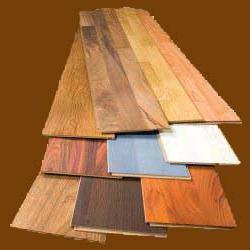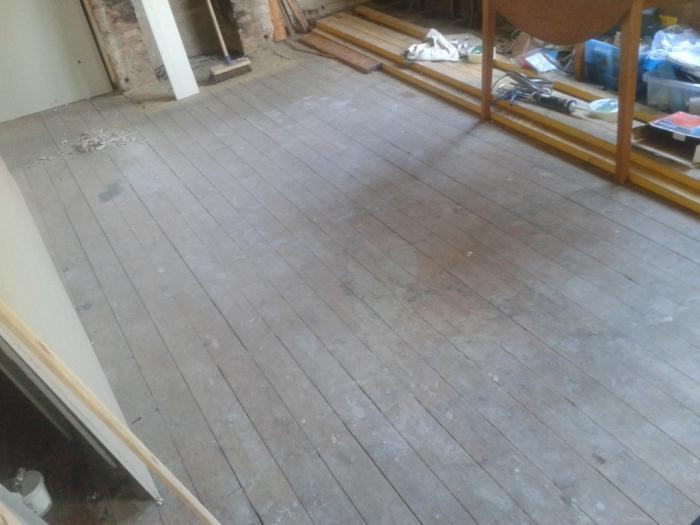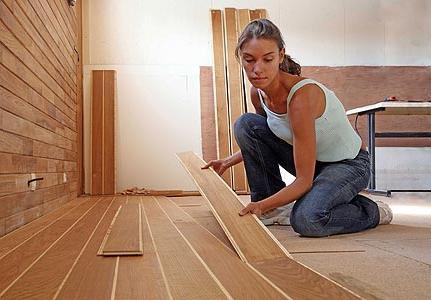Laying the laminate diagonally
Laminate flooring, and simplylaminate, very quickly won the position as one of the most comfortable, beautiful, fashionable, aesthetic, inexpensive and durable (you can still continue) materials for finishing the floors in the living room. Indeed, he has many advantages, but there are fewer shortcomings. Perhaps the main one is the synthetic basis, the non-naturalness of the material, in spite of the fact that it looks very presentable, well, and still has a low moisture resistance (although now it produces types of moisture-resistant laminate).
There are different ways of laying the laminate. The most standard - deck, when the boards are laid along the wall of the room from the window to the door with a shift, i.e. each of the rows is shifted relative to the other by approximately 25 cm so that the end joints do not coincide with the adjacent rows. There is another - laying the laminate on the diagonal - more "bold" and interesting, and in small rooms also visually expanding the space. Designers are advised to use such a styling in relatively empty, open spaces not furnished. So the original drawing on the floor will be visible in all its glory. Laying a laminate on a diagonal is traditionally considered more labor-intensive, complex and less economical, since there is a lot of waste. However, it does not differ much from the traditional, and if you show some ingenuity, then the material will not leave much more. But let's start in order.
Preparation of the base for laminate
Before the beginning of finishing worksmake sure that the foundation of the floor is flat, without protruding hillocks and dents. Unevenness in a concrete screed is allowed no more than 3 mm for each meter of surface. Do not necessarily put laminated boards on the screed. As a basis can be a dry and durable floor, covered with linoleum, carpet or old parquet. In this case, you can ignore the use of a special substrate for the laminate, which, however, must be used on a concrete screed. In addition to the substrate, a dense polyethylene film is spread on the concrete screed, which will protect the coating from excessive moisture. The film and the substrate are joined together by a scotch tape, making a small admission to the wall under the plinth.
Selection and preparation of finishing material
The diagonal laying of the laminate is indeedrequires more material consumption. The reserve is approximately 7-10% of the total. For those who are knowledgeable in the construction business of the owners, this percentage can be reduced to 5% if you take into account some of the nuances during the work. But about this below. Builders have a standard formula for the required number of boards, which is calculated as follows: 7% of the waste is added to the total area of the room, and this amount is divided by the area of the boards indicated on one package.
When choosing a laminate, one should take into account its classwear resistance (the most running - 32), as well as the width and length of the boards and the type of their connection. The easiest way to work with a lock joint without the use of glue. Even a beginner can cope with such work. Than the boards are wider and longer, the less will be the seams. Wide boards stack faster, and long boards are preferable in a large room.
While the rough floor is being prepared, the laminate boards should be freed from the packaging and left at room temperature for two days to lie around. Then you can proceed with the installation.
Laying the laminate diagonally
You need to start from the far corner of the room nearwindows and move to the door, taking into account the direction of the light flux and the sun's rays. The angle of the board can vary from 30 to 45 degrees. From the wall must retreat by 1 cm, in order to avoid possible deformation of the coating as it expands from temperature fluctuations.
Before you start, it's best to draw a drawingfuture laying, where to take into account the angle of slope of the boards, all the ledges and possible obstacles. This will create a more vivid picture and help save material. In order to save material, finishers are advised to begin work from the middle of the room, stretching from one to the other corner of the rope, which will serve as a boundary. Laying the laminate diagonally is first done on the left side of the room, and then on the right. In this case, the cut will go to the course, which remained when working on the left side.
At first, the boards are connected with end sections, andthen the entire prepared row snaps to the previous one. Be sure to ensure that the end sections of each row do not coincide, but are 25-30 cm apart from each other, i.e. each time to shift them.
Laminate is a modern, beautiful and versatile material, and its laying, even diagonally, is quite an accessible and easy kind of work.
</ p>




